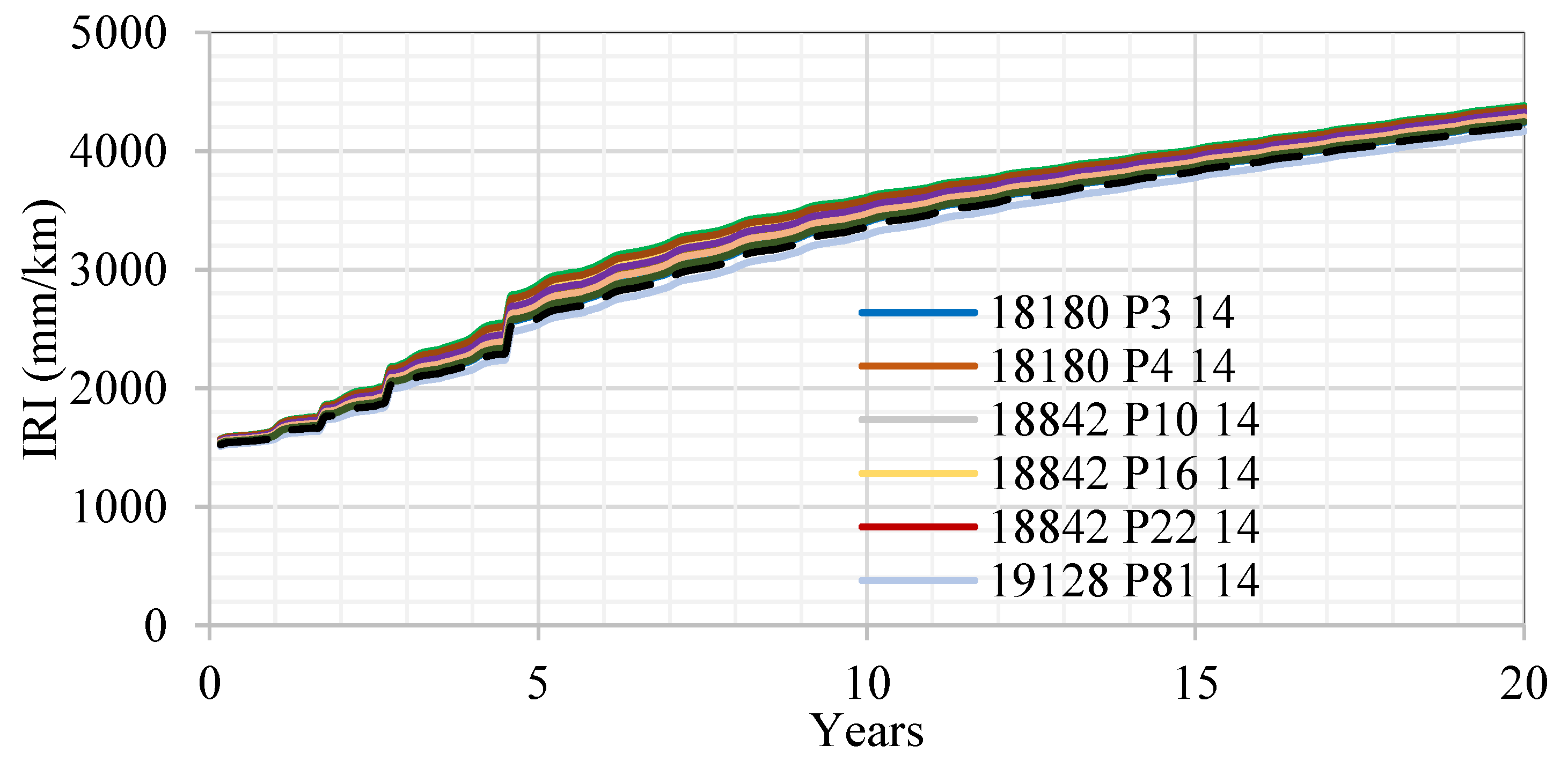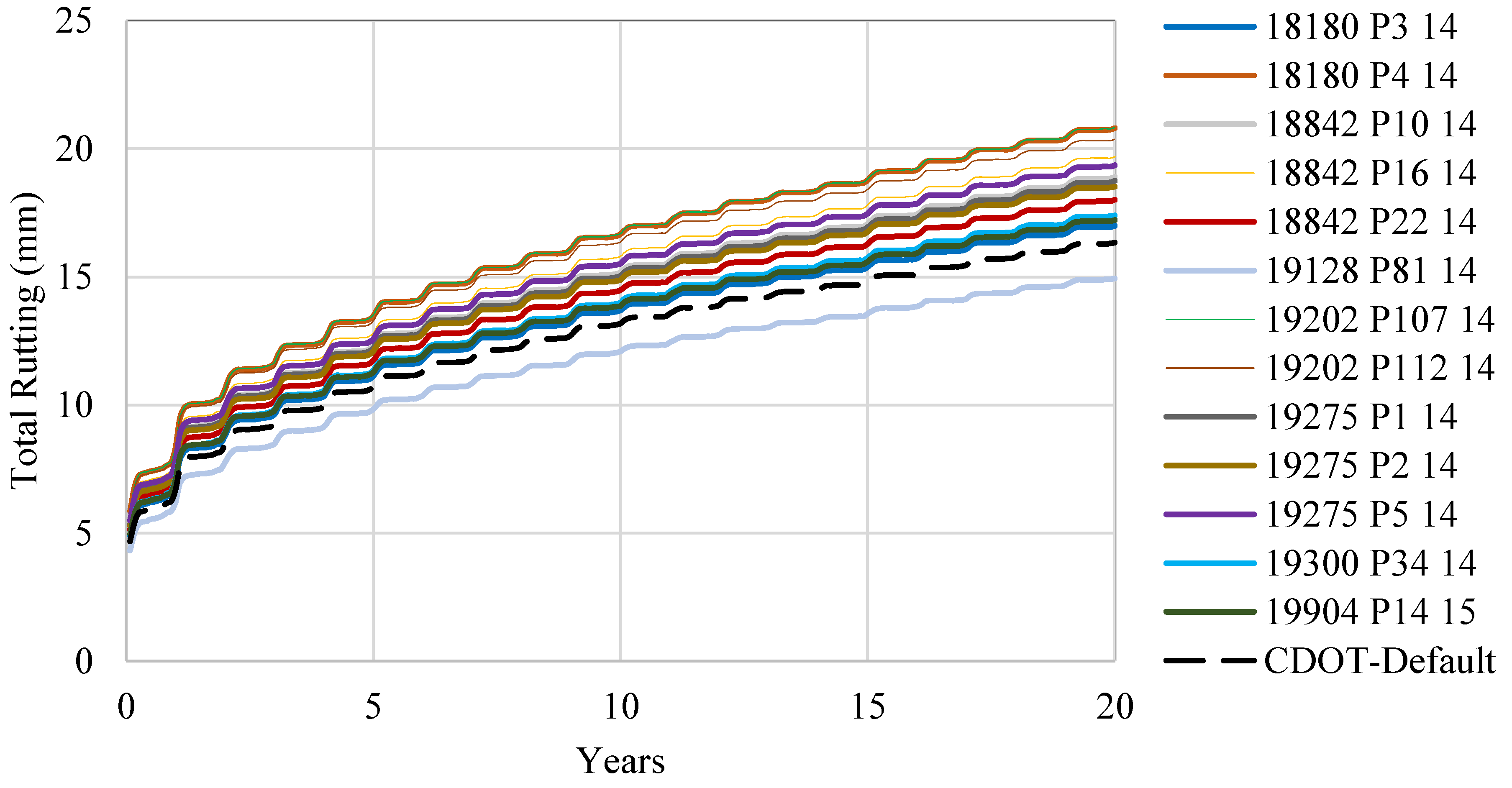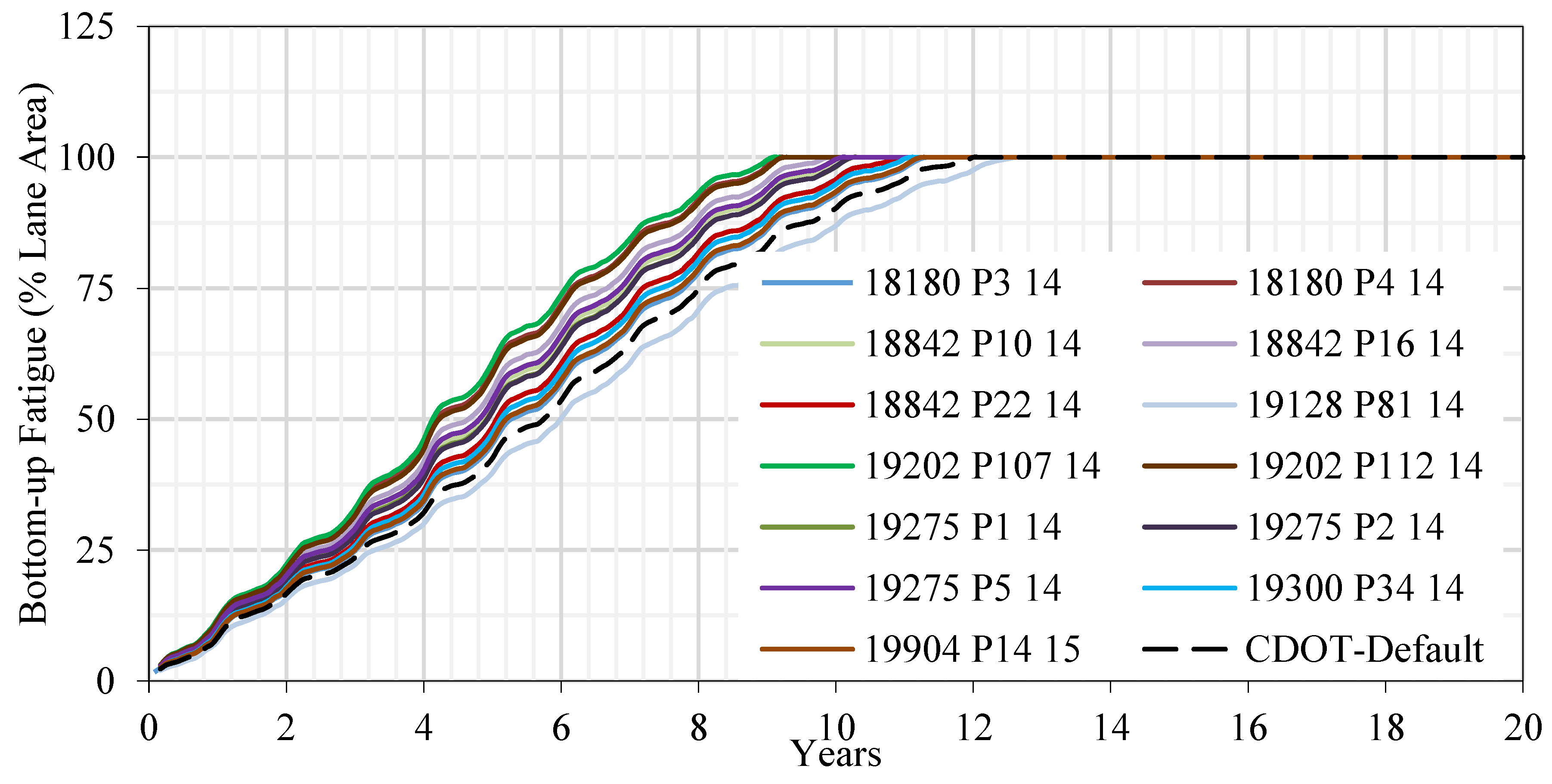Effects of Mix Factors on the Mechanistic-Empirical Flexible Pavement Design
Abstract
:1. Introduction
2. Materials
3. Dynamic Modulus (E*) Testing
- (a)
- Samples of 4-in. (100-mm) diameter and 6-in. (150-mm) height are prepared in the laboratory or field cores are collected.
- (b)
- The gauge points for the AMPT instrumentation are attached.
- (c)
- The full E* test is run on each specimen at three different temperatures of 4 °C, 20 °C, and 40 °C. The testing frequencies are 0.1 Hz, 1 Hz, and 10 Hz at each temperature with the exception that another (4th) frequency of 0.01 Hz is adopted for 40 °C.
- (d)
- N-value tests are run on two of the samples from each set of five at 50 °C.
4. Developing Dynamic Modulus Mastercurves for AASHTOWare
- = dynamic modulus
- ωr = reduced frequency, Hz
- Max = limiting maximum modulus, ksi
- Min = limiting minimum modulus, ksi
- β and γ = fitting parameters
- ωr = reduced frequency at the reference temperature
- ω = loading frequency at the test temperature
- Tr = reference temperature, °K
- T = test temperature, °K
- ∆Ea = activation energy (treated as a fitting parameter)
- a(T) = shift factor at temperature T
- limiting maximum dynamic modulus, psi
- VMA = voids in mineral aggregates, %
- VFA = voids filled with asphalt, %
- Max. |E*| (ksi): 3237.2 (22,304 MPa)
- Min. |E*| (ksi): 9.2 (63.39 MPa)
- Beta, β: −0.91764
- Gamma, γ: −0.54361
- ∆Ea: 239,361
- Coefficient of determination (R2) = 0.993
- Se/Sy = 0.06
5. Effects of Mix Factors on Performance
- (a)
- International roughness index (IRI);
- (b)
- Total rutting;
- (c)
- Rutting in asphalt layer (only);
- (d)
- Bottom-up fatigue cracking (FC) and;
- (e)
- Top-down longitudinal cracking (TDC).
- IRI (mm/km) = 1579.92 − 34.369 Vbe − 14.363 Va + 66.184 VMA + 17.604 VFA + 22.423 AC
- Total rutting (mm) = −12.11 − 0.5258 Vbe − 0.165 Va + 0.9525 VMA + 0.2515 VFA + 0.3048 AC
- Rutting in HMA (mm) = −14.2977 − 0.4775 Vbe − 0.198 Va + 0.922 VMA + 0.2388 VFA + 0.2134 AC
- FC (%) = −13.1366 − 0.461 Vbe − 0.1364 Va + 0.9536 VMA + 0.2036 VFA + 0.5026 AC
- TDC (m/km) = −467.33 − 19.12 Vbe − 7.7193 Va + 33.1948 VMA + 9.818 VFA + 11.2242 AC
6. Conclusions
Author Contributions
Funding
Acknowledgments
Conflicts of Interest
References
- Clyne, T.R.; Li, X.; Marasteanu, M.O.; Skok, E.L. Dynamic and Resilient Modulus of Mn/DOT Asphalt Mixtures; Report No. MN/ RC-2003-09; Minnesota Department of Transportation: St. Paul, MN, USA, 2003.
- Rahman, A.; Islam, M.R.; Tarefder, R.A. Modifying the Viscosity Based Witczak Model and Developing Phase Angle Predictive Model for New Mexico’s Superpave Mixes. In Proceedings of the Transportation Research Board (TRB) 95th Annual Meeting, Washington, DC, USA, 10–14 January 2016. Paper ID. 16-3180. [Google Scholar]
- Birgisson, B.; Sholar, G.; Roque, R. Evaluation of Predicted Dynamic Modulus for Florida Mixtures. In Proceedings of the 84th Annual Meeting of the Transportation Research Board, Washington, DC, USA, 9–13 January 2005. Paper No. 05-1309. [Google Scholar]
- Ceylan, H.; Schwartz, C.; Kim, S.; Gopalakrishnan, K. Accuracy of Predictive Models for Dynamic Modulus of Hot-Mix Asphalt. J. Mater. Civ. Eng. 2009, 21, 286–293. [Google Scholar] [CrossRef] [Green Version]
- Christensen, D.W.; Pellinen, T.K.; Bonaquist, R.F. Hirsch Model for Estimating the Modulus of Asphalt Concrete. J. Assoc. Asph. Paving Technol. 2003, 72, 97–121. [Google Scholar]
- Kim, Y.R.; King, M.; Momen, M. Typical Dynamic Moduli Values of Hot Mix Asphalt in North Carolina and Their Prediction. In Proceedings of the 84th Annual Meeting of the Transportation Research Board, Washington, DC, USA, 9–13 January 2005. Paper No. 05-2568. [Google Scholar]
- Mohammad, L.N.; Wu, Z.; Myers, L.; Cooper, S.; Abadie, C. A Practical Look at Simple Performance Tests: Louisiana’s Experience. J. Assoc. Asph. Paving Technol. 2005, 74, 557–600. [Google Scholar]
- Sakhaeifar, M.; Kim, Y.; Kabir, P. New predictive models for the dynamic modulus of hot mix asphalt. Constr. Build. Mater. 2015, 76, 221–231. [Google Scholar] [CrossRef]
- Tran, N.H.; Hall, K.D. Evaluating the Predictive Equation in Determining Dynamic Moduli of Typical Asphalt Mixtures Used in Arkansas. J. Assoc. Asph. Paving Technol. 2005, 74, 1–17. [Google Scholar]
- Hu, H.; Shen, S. An Investigation of Dynamic Modulus and Flow Number Properties of Asphalt Mixtures in Washington State; Final Report, No. 709867; USDOT, Office of the Secretary of Transportation: Washington, DC, USA, 2012. [Google Scholar]
- AASHTO TP 62. Standard Method of Test for Determining Dynamic Modulus of Hot Mix Asphalt (HMA); American Association of State Highway and Transportation Officials (AASHTO): Washington, DC, USA, 2007; pp. 1–21. [Google Scholar]
- CDOT. Colorado Department of Transportation 2019 Pavement Design Manual; Colorado Department of Transportation (CDOT): Denver, CO, USA, 2019.






| Mix ID | NMAS, in. (mm) | Binder | Number of Gyrations |
|---|---|---|---|
| S (100) PG 64-22 | 0.75 (19) | PG 64-22 | 100 |
| S (100) PG 76-28 | 0.75 (19) | PG 76-28 | 100 |
| SMA PG 76-28 | 0.50 (12.5) | PG 76-28 | 100 |
| SX (75) PG 58-28 | 0.50 (12.5) | PG 58-28 | 75 |
| SX (75) PG 58-34 | 0.50 (12.5) | PG 58-34 | 75 |
| SX (75) PG 64-22 | 0.50 (12.5) | PG 64-22 | 75 |
| SX (75) PG 64-28 | 0.50 (12.5) | PG 64-28 | 75 |
| SX (100) PG 58-28 | 0.50 (12.5) | PG 58-28 | 100 |
| SX (100) PG 64-22 | 0.50 (12.5) | PG 64-22 | 100 |
| SX (100) PG 64-28 | 0.50 (12.5) | PG 64-28 | 100 |
| SX (100) PG 76-28 | 0.50 (12.5) | PG 76-28 | 100 |
| Temperature (°C) | Frequency (Hz) | Dynamic Modulus (ksi) | Dynamic Modulus (MPa) |
|---|---|---|---|
| 4 | 0.1 | 1206 | 8309 |
| 4 | 1.0 | 1750 | 12,058 |
| 4 | 10.0 | 2316 | 15,957 |
| 20 | 0.1 | 322 | 2219 |
| 20 | 1.0 | 638 | 4396 |
| 20 | 10.0 | 1110 | 7648 |
| 35 | 0.01 | 34 | 234 |
| 35 | 0.1 | 54 | 372 |
| 35 | 1.0 | 117 | 806 |
| 35 | 10.0 | 288 | 1984 |
| No. | Temperature | Frequency (Hz) | |E*| | |E*| | |
|---|---|---|---|---|---|
| °C | °F | Ksi | MPa | ||
| 1 | −10.0 | 14 | 25 | 2939 | 20,250 |
| 2 | −10.0 | 14 | 10 | 2867 | 19,754 |
| 3 | −10.0 | 14 | 5 | 2803 | 19,313 |
| 4 | −10.0 | 14 | 1 | 2613 | 18,004 |
| 5 | −10.0 | 14 | 0.5 | 2512 | 17,308 |
| 6 | −10.0 | 14 | 0.1 | 2227 | 15,344 |
| 7 | 4.4 | 40 | 25 | 2404 | 16,564 |
| 8 | 4.4 | 40 | 10 | 2234 | 15,392 |
| 9 | 4.4 | 40 | 5 | 2091 | 14,407 |
| 10 | 4.4 | 40 | 1 | 1717 | 11,830 |
| 11 | 4.4 | 40 | 0.5 | 1544 | 10,638 |
| 12 | 4.4 | 40 | 0.1 | 1137 | 7834 |
| 13 | 21.1 | 70 | 25 | 1338 | 9219 |
| 14 | 21.1 | 70 | 10 | 1108 | 7634 |
| 15 | 21.1 | 70 | 5 | 942 | 6490 |
| 16 | 21.1 | 70 | 1 | 607 | 4182 |
| 17 | 21.1 | 70 | 0.5 | 489 | 3369 |
| 18 | 21.1 | 70 | 0.1 | 284 | 1957 |
| 19 | 37.8 | 100 | 25 | 443 | 3052 |
| 20 | 37.8 | 100 | 10 | 325 | 2239 |
| 21 | 37.8 | 100 | 5 | 255 | 1757 |
| 22 | 37.8 | 100 | 1 | 144 | 992 |
| 23 | 37.8 | 100 | 0.5 | 113 | 779 |
| 24 | 37.8 | 100 | 0.1 | 68 | 469 |
| 25 | 54.4 | 130 | 25 | 118 | 813 |
| 26 | 54.4 | 130 | 10 | 87 | 599 |
| 27 | 54.4 | 130 | 5 | 70 | 482 |
| 28 | 54.4 | 130 | 1 | 45 | 310 |
| 29 | 54.4 | 130 | 0.5 | 38 | 262 |
| 30 | 54.4 | 130 | 0.1 | 28 | 193 |
| Groups | Climate Station | AADTT |
|---|---|---|
| S (100) PG 64-22 | Denver 12342 | 7000 |
| S (100) PG 76-28 | Denver 12342 | 7000 |
| SMA PG 76-28 | Denver 12342 | 7000 |
| SX (75) PG 58-28 | Gunnison 93007 | 3000 |
| SX (75) PG 58-34 | Gunnison 93007 | 3000 |
| SX (75) PG 64-22 | Pueblo 93058 | 3000 |
| SX (75) PG 64-28 | Gunnison 93007 | 3000 |
| SX (100) PG 58-28 | Gunnison 93007 | 7000 |
| SX (100) PG 64-22 | Colorado Spring 93037 | 7000 |
| SX (100) PG 64-28 | Pueblo 93058 | 7000 |
| SX (100) PG 76-28 | Trinidad 23070 | 7000 |
| Vbe (%) | Va (%) | VMA (%) | VFA (%) | AC (%) | Pit | |
|---|---|---|---|---|---|---|
| 18180 P3 14 | 12.24 | 6.66 | 17.1 | 61.2 | 5.00 | Morrison, Plate River |
| 18180 P4 14 | 10.31 | 6.66 | 17.9 | 63.4 | 5.00 | Morrison, Plate River |
| 18842 P10 14 | 11.63 | 5.00 | 18.3 | 62.8 | 5.30 | Tezak Fountain/I25 |
| 18842 16 14 | 11.39 | 6.98 | 18.4 | 62.4 | 5.30 | Tezak Fountain/I25 |
| 18842 P22 14 | 11.44 | 6.52 | 18.1 | 64.3 | 5.30 | Tezak Fountain/I25 |
| 19128 P81 14 | 13.18 | 6.90 | 17.6 | 60.8 | 5.50 | Evans |
| 19202 P107 14 | 11.94 | 6.00 | 18.8 | 64.2 | 6.34 | Four Corners |
| 19202 P112 14 | 11.29 | 6.00 | 18.3 | 61.2 | 5.95 | Four Corners |
| 19275 P1 14 | 13.41 | 5.78 | 17.0 | 66.3 | 5.65 | --- |
| 19275 P2 14 | 13.41 | 6.60 | 18.1 | 65.9 | 5.65 | --- |
| 19275 P5 14 | 13.41 | 6.14 | 17.3 | 65.2 | 5.65 | --- |
| 19300 P34 14 | 12.04 | 5.64 | 16.7 | 66.4 | 6.00 | Craig Ranch |
| 19655 P18 14 | 11.05 | 6.06 | 16.7 | 64.3 | 5.60 | Valardi |
| 19904 P14 15 | 13.43 | 6.40 | 17.1 | 62.5 | 5.50 | Spec Agg/Riverbend/Cottonwood |
| Vbe (%) | Va (%) | VMA (%) | VFA (%) | AC (%) | |
|---|---|---|---|---|---|
| IRI | 4 Increases 4 Decreases 3 N/A | 5 Increases 4 Decreases 2 N/A | 6 Increases 3 Decreases 2 N/A | 6 Increases 3 Decreases 2 N/A | 4 Increases 2 Decreases 5 N/A |
| Total Rutting | 4 Increases 4 Decreases 3 N/A | 5 Increases 4 Decreases 2 N/A | 6 Increases 3 Decreases 2 N/A | 6 Increases 3 Decreases 2 N/A | 3 Increases 3 Decreases 5 N/A |
| Rutting in HMA | 4 Increases 3 Decreases 4 N/A | 4 Increases 4 Decreases 3 N/A | 7 Increases 3 Decreases 1 N/A | 5 Increases 3 Decreases 3 N/A | 3 Increases 3 Decreases 5 N/A |
| FC (%) | 4 Increases 4 Decreases 3 N/A | 5 Increases 4 Decreases 2 N/A | 6 Increases 3 Decreases 2 N/A | 6 Increases 3 Decreases 2 N/A | 3 Increases 3 Decreases 5 N/A |
| TDC | 4 Increases 4 Decreases 3 N/A | 5 Increases 4 Decreases 2 N/A | 6 Increases 3 Decreases 2 N/A | 7 Increases 2 Decreases 2 N/A | 4 Increases 2 Decreases 5 N/A |
© 2019 by the authors. Licensee MDPI, Basel, Switzerland. This article is an open access article distributed under the terms and conditions of the Creative Commons Attribution (CC BY) license (http://creativecommons.org/licenses/by/4.0/).
Share and Cite
Islam, M.R.; Kalevela, S.A.; Nesselhauf, S.K. Effects of Mix Factors on the Mechanistic-Empirical Flexible Pavement Design. Designs 2019, 3, 36. https://doi.org/10.3390/designs3030036
Islam MR, Kalevela SA, Nesselhauf SK. Effects of Mix Factors on the Mechanistic-Empirical Flexible Pavement Design. Designs. 2019; 3(3):36. https://doi.org/10.3390/designs3030036
Chicago/Turabian StyleIslam, Md Rashadul, Sylvester A. Kalevela, and Shelby K. Nesselhauf. 2019. "Effects of Mix Factors on the Mechanistic-Empirical Flexible Pavement Design" Designs 3, no. 3: 36. https://doi.org/10.3390/designs3030036
APA StyleIslam, M. R., Kalevela, S. A., & Nesselhauf, S. K. (2019). Effects of Mix Factors on the Mechanistic-Empirical Flexible Pavement Design. Designs, 3(3), 36. https://doi.org/10.3390/designs3030036





